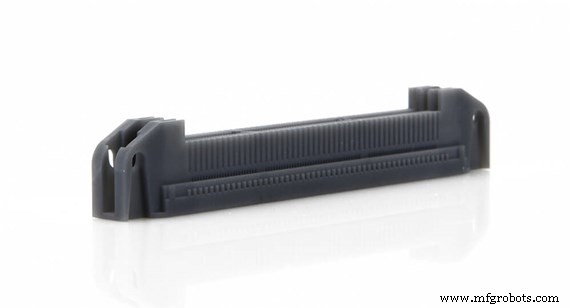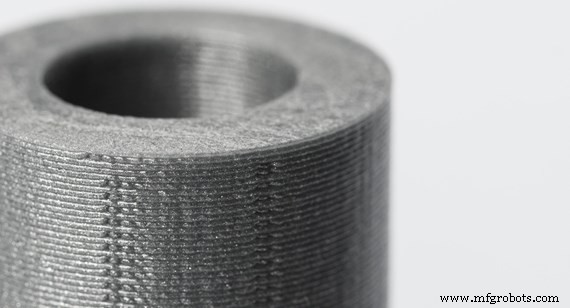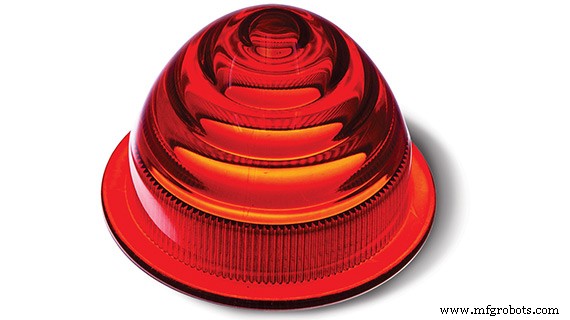SLA vs. FDM:Membandingkan Teknologi Pencetakan 3D Umum
Manufaktur aditif, dan khususnya pencetakan 3D modern, telah berjalan jauh sejak pengembangan awalnya pada tahun 1983. Komponen cetakan 3D saat ini dapat mencapai resolusi dan toleransi yang tinggi. Dua dari teknik yang lebih umum adalah stereolithography (SLA) dan model deposisi menyatu (FDM). Meskipun keduanya muncul pada tahun 1980-an, keduanya menggunakan cara yang sangat berbeda untuk membuat suku cadang, dan sebagai hasilnya, suku cadang akhir masing-masing memberikan manfaat yang berbeda-beda.

Suku cadang SLA dibuat dengan resin MicroFine Grey™ Protolabs mencapai resolusi presisi mikro.
Bagaimana Cara Kerja SLA?
SLA menggunakan resin photopolymer sebagai bahan baku komponennya. Photopolymers membutuhkan sinar ultraviolet yang kuat dari laser untuk mengatur, dan itulah ide utama di balik SLA. Pembangunan berlangsung di atas platform yang terendam dalam resin. Sebuah laser duduk di atas tangki dan, diarahkan oleh cermin presisi, memadukan resin cair, mengeraskannya untuk mencapai bentuk bagian yang diinginkan, satu lapisan pada satu waktu. Struktur pendukung adalah lapisan pertama yang dibuat, memastikan bahwa bagian tersebut diikat dengan aman ke platform dan didukung secara memadai. Dengan setiap lintasan, bilah recoator memecah tegangan permukaan resin di atas bagian tersebut. Bagian tersebut kemudian dibuat dari bawah ke atas.
Bagaimana Cara Kerja FDM?
Salah satu bentuk pencetakan 3D paling awal, FDM ditemukan oleh salah satu pendiri Stratasys, Scott Crump. Konsepnya sederhana—sangat mirip dengan menggunakan lem tembak. Filamen termoplastik atau gulungan plastik dipanaskan hingga titik leleh. Plastik cair yang panas keluar melalui nosel untuk membuat lapisan tunggal tipis di sepanjang sumbu X dan Y pada platform pembuatan. Lapisan mendingin dan mengeras dengan cepat. Saat setiap lapisan selesai, platform diturunkan dan plastik cair tambahan diendapkan, menumbuhkan bagian secara vertikal (sepanjang sumbu Z).
Properti Material SLA dan FDM
| Proses | Cara Kerja | Kekuatan | Selesai | Materi Umum |
|---|
| SLA | fotopolimer yang diawetkan dengan laser | 2.500-10.000 (psi)
17,2-68,9 (MPa) | Lapisan aditif khas 0,002-0,006 in. (0,051-0,152mm) | Photopolymer mirip termoplastik mirip dengan ABS, PC, dan PP |
|---|
| FDM | Ekstrusi menyatu | 5.200-9.800 (psi)
35,9-67,6 (MPa) | Lapisan aditif khas 0,005-0,013 inci (0,127-0,330mm) | ABS, PC, PC/ABS, PPSU, PEEK, ULTEM |
|---|

Pada bagian FDM ini terlihat garis layer. Foto:3Dhubs.com
Neither of these techniques creates parts as strong as ones that are injection molded, for example, but they are suitable for rapid prototyping. SLA’s thin layers and strong bonding between the layers makes its parts smoother, with minimal striations along the Z axis, the direction of the build.
SLA Considerations
If details and surface smoothness are important for your part, SLA handily beats FDM. In part, because of its roots in laser technology, SLA parts can offer incredibly fine detail, yet pricing is competitive. Also, the SLA ultraviolet light curing process avoids FDM’s issues caused by heat compressing previously drawn layers. Equally important, SLA offers many additional finishing options, such as dyeing and texturing.
With SLA, there are three resolution levels from which to choose, ranging from 0.004 in. (0.1016mm) to 0.001 in. (0.0254mm) for layer thickness. Choosing one over the other not only affects part quality, but manufacturing time, too. Minimum feature size can be as small as 0.0025 in. (0.0635mm) on the XY plane and 0.008 in. (0.2032mm) on the Z axis.
One important issue with SLA parts is their sensitivity to light. As photopolymers, they can degrade from exposure to UV rays, such as sunlight. Adding a protective coating can slow this process.
MicroFine™ is an exclusive Protolabs material available in gray and green. This micro-resolution, ABS-like material can print layers that are extremely thin:just 0.001 in. (0.0254mm). That kind of precision is a prerequisite for building parts with many small feature details and is regularly used for small and highly accurate medical components.
FDM Considerations
FDM uses engineering-grade materials (see chart above) and offers a range of color options. With some FDM printers, parts can be as large as 427 in. x 153 in. x 172 in. (10,845.8mm x 3,886.2mm x 4,368.8mm). Essentially it depends on the size of the build space. Also, FDM parts are moderately priced, making it ideal for hobbyists, dental offices, and classrooms.
FDM’s tolerance is dependent on how the machine is set up, but can be as small as +/-0.0035 in. (+/-0.0015mm). Layer thickness varies based on the material you’re using, and some printers can print as thin as 0.001 in. (0.0254mm), although this would lead to long print times and may not be possible with larger parts.
Because temperature affects the core material, FDM parts are subject to rippled exterior edges caused as new layers are dropped atop previous layers. These Z-axis issues also cause weakness in the build. So, a part’s strength is entirely dependent on the direction in which it was built.
FDM does not do well with wide, flat areas, and has difficulties printing sharp corners, so adding fillets to your design makes sense. For all these reasons, prototyping with FDM works well when accuracy and surface finish aren't critical.
Although FDM gets the check for cost, SLA is quite competitive, especially for cosmetic prototypes with intricate designs. It’s also a go-to process to create forms for injection molding and casting.
When to Use SLA and FDM
With all of these considerations in mind, here is a list of when to use either method.
Use SLA :
- For rapid, complex prototyping
- When precision and a smooth surface finish is important
- When high resolution, fine detail, and accuracy is necessary
- For creating molds for casting to facilitate mass production
- When strength and durability of the model is not crucial (models made from resin may suffer when exposed to the sun for long periods)
Use FDM :
- For prototyping
- When a selection of colors is needed
- For low-cost models
- When precision and surface finish aren’t crucial
- For hobbyist and maker projects

SLA produced this clear, red taillight with a smooth finish and custom post-production painting.
For additional help, feel free to contact a Protolabs applications engineer at 877-479-3680 or [email protected]. To get your next design project started today, simply upload a 3D CAD model for an interactive quote within hours.




 Suku cadang SLA dibuat dengan resin MicroFine Grey™ Protolabs mencapai resolusi presisi mikro.
Suku cadang SLA dibuat dengan resin MicroFine Grey™ Protolabs mencapai resolusi presisi mikro.  Pada bagian FDM ini terlihat garis layer. Foto:3Dhubs.com
Pada bagian FDM ini terlihat garis layer. Foto:3Dhubs.com 